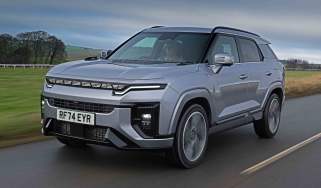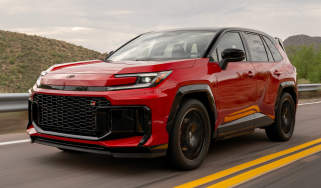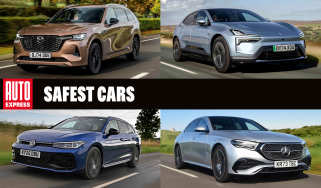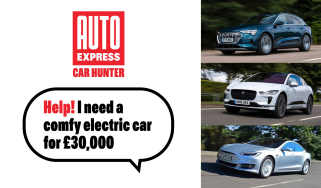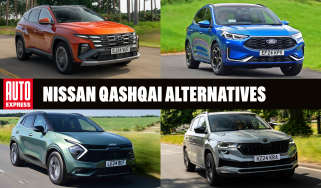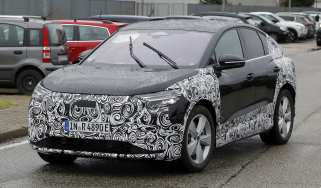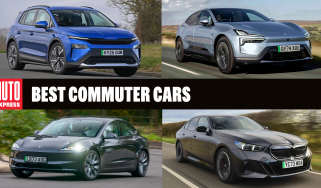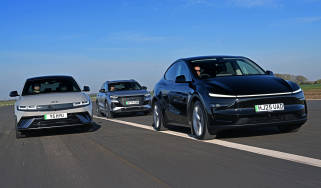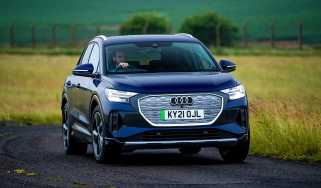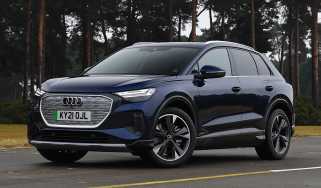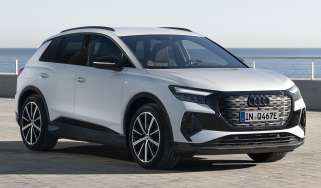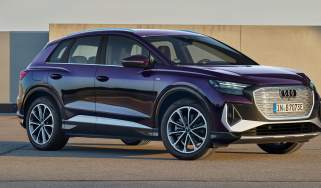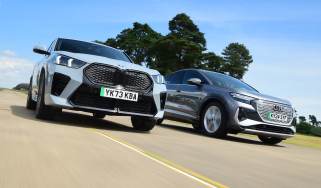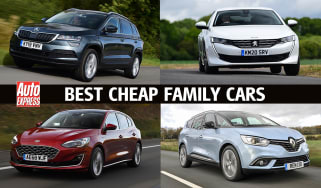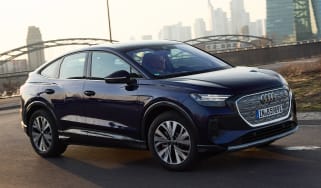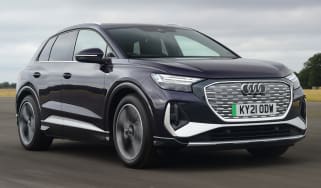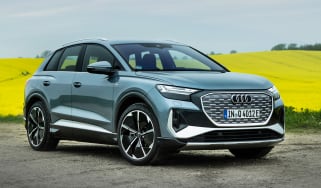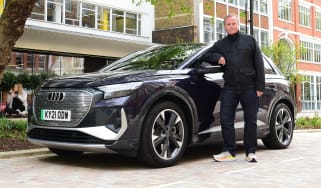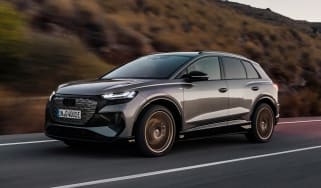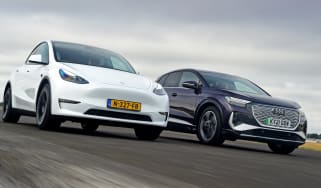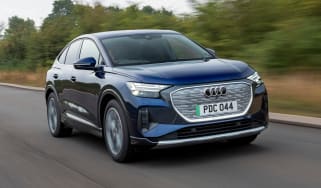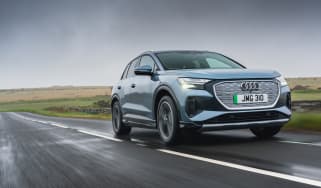Audi Q4 e-tron review
The Audi Q4 e-tron is a popular premium EV with efficiency and upmarket style that stood out on our tests

Our opinion on the Audi Q4 e-tron
Audi has done a good job of turning the Volkswagen Group’s electric platform into a proper Audi with the Q4 e-tron. It features the kind of materials and high-quality switchgear that the company is famous for, and it delivers an impressive amount of space for its compact size.
The electric powertrain returns decent efficiency when compared with rivals and the performance on offer is pretty good, too. We’d steer clear of the Sportback model, because it only offers a marginally better driving range than the standard Q4 e-tron with worse practicality for a higher price. A number of rivals offer better value for money than Audi’s smallest EV so you’ve got to want that brand image and extra quality.
About the Audi Q4 e-tron
Audi’s electric line-up is expanding quickly, but one of its first EV efforts, the Q4 e-tron, remains among the most popular choices with buyers. It’s easy to see why; this family SUV offers the Audi premium badge appeal at a price that isn’t too far beyond the level of numerous mainstream alternatives.
It’s a well trodden formula for Audi; after all, the Audi A3 hatchback shares its mechanical make-up with a Volkswagen Golf, and in the Q4, Audi uses the same MEB architecture as the Volkswagen ID.4 with a posher bias to the cabin. As with the ID.4, there’s a conventional five-door SUV variant and a sportier ‘coupe SUV’ alternative, in the shape of Audi Q4 e-tron Sportback.
Used - available now
The Q4 e-tron line-up includes two battery sizes, three power outputs and either rear-wheel drive or quattro four-wheel drive. The entry point is the 40 e-tron, which has a 63kWh battery and rear-wheel drive, while the 45 e-tron has more power and an 82kWh battery. This model is also available with a quattro 4x4 system comprising front and rear electric motors, while the same set-up is standard with the 55 e-tron, which is more powerful again, but has the same 82kWh battery.
Audi Q4 e-tron prices and latest deals
Currently the Q4 e-tron is the smallest electric model in Audi’s line-up, but prices starting from around £47,500 pitch it close to the larger Audi Q5 SUV, although the all-electric powertrains will deliver lower everyday running costs.
Trim levels comprise Sport, S line and Black Edition variants. The price jump from Sport to S line is around £3,500, while the Black Editions are another £1,500 or so on top of that.
Use the Auto Express Buy A Car service to check out used deals of the Audi Q4 e-tron where prices start from under £20,000. You can see what finance offers are available on new cars, too.
Performance & driving experience

Pros |
|
Cons |
|
The four powertrains to choose from in the Q4 e-tron line-up can all be paired with any of the three trim levels. Audi hasn’t quite dumped its slightly confusing powertrain number strategy throughout its line-up, though, and it’s still applied to the Q4 e-tron.
Whichever powertrain is fitted, the latest Q4 e-tron is smooth and torquey, with a well-judged throttle response that feels much more positive than in the slightly lethargic early Q4s. Black Edition models have paddles on the wheel to adjust energy recuperation. We’d recommend setting the recuperation to manual in the infotainment to switch off the unpredictable adaptive regen system.
Electric motors, 0-60mph acceleration and top speed
The Q4 range starts with the 40 e-tron that uses a single motor driving the rear wheels and produces 201bhp, which is enough for an 8.1-second 0-62mph time. This car gets a 63kWh battery (59kWh usable). Next is the 45 e-tron, which has the same battery and motor configuration, but power climbs to 282bhp, which trims the 0-62mph time to 6.7 seconds, despite the extra 105kg of the larger 82kWh (77kWh usable) battery.
The quattro model offers the same 282bhp but drives all four wheels. It’s just one-tenth of a second quicker from 0-62mph than the rear-drive version, so we’d save cash and go without the quattro system. Unless you want the top performer, that is; the 55 e-tron quattro pumps out 335bhp, which trims the 0-62mph time to 5.4 seconds. This model uses the same 82kWh battery as the 45 e-tron.
| Model | Power | 0-62mph | Top speed |
| 40 e-tron | 201bhp | 8.1s | 99mph |
| 45 e-tron | 282bhp | 6.7s | 112mph |
| 45 e-tron quattro | 282bhp | 6.6s | 112mph |
| 55 e-tron quattro | 335bhp | 5.4s | 112mph |
Town driving, visibility and parking
The Q4 e-tron’s turning circle is much tighter than cars from rivals, including the Tesla Model Y and Hyundai Ioniq 5, so it’s a little easier to manoeuvre it into a tight parking spot. On the largest 21-inch wheels and the lowered suspension of the Black Edition (both it and the S line sit 15mm lower than the entry-level Sport trim) the ride is barely on the right side of firm. It’s a little thumpy over big bumps at low speeds, which is why we’d aim for models with smaller wheel sizes and a little more sidewall on their tyres.
Country road driving and handling
The Audi strikes a competent ride and handling balance on a twisty road, which makes it better to drive than a Tesla Model Y, and a big part of that is down to its steering. It’s well matched to the responses of the chassis, so you can load the car up through a corner without feeling like you’re stuck in a computer game, as is the case with the Tesla.
The Audi is at its best in rear-wheel-drive form, where a little throttle application coming out of a corner gently pushes the car around from the back, in a way that makes it feel more sweetly balanced than many other EV options in this segment.
The one proviso is that the Q4 e-tron can pitch onto its back axle under very hard acceleration, which can make the front wheels a little light if you’re clumsy with the right pedal in a corner. The BMW iX1 is sharper through corners but is let down by its firm ride and lifeless steering, while one of the best in the class for drivers is the Ford Capri. Using the same MEB underpinnings as the Audi, Ford’s engineers have managed to hit a real sweet spot between comfort and fun.
Motorway driving and long-distance comfort
The Audi’s high-speed stability makes it an accomplished long-distance cruiser. However, both the Model Y and the iX1 have a narrow advantage when it comes to isolating their occupants from road and wind noise.
“In a class where few cars stand out for the way they drive, Audi still deserves credit for making the Q4 e-tron among the best of the admittedly rather average bunch.” – Alex Ingram, chief reviewer
Range, charging & running costs
| Pros |
|
| Cons |
|
Electric range, battery life and charge time
Officially, the Q4 e-tron S line with the 45 quattro powertrain can cover 319 miles on a single charge (the Sport version on smaller wheels and slightly less kit can travel a mile further on a full charge). On our most recent test of this model, we recorded a real-world range of 262 miles, which was the result of efficiency of 3.4 miles per kilowatt hour.
With more urban and rural driving, we’re sure that range would improve; our figure included motorway driving, which is less flattering for an EV’s range. Once again, there’s a reason to opt for the rear-wheel-drive 45 model instead of the quattro; officially, it’ll travel up to 23 miles further on a charge.
The smaller battery of the 40 e-tron delivers a range of up to 250 miles in Sport spec, while the most powerful 55 e-tron quattro matches the entry model and less powerful quattro variant with an official range of 320 miles in Sport guise.
Charging speeds top out at 175kW in the big-battery models, which translates to a 10-80 per cent charging time – the equivalent of adding 183 miles of real-world range, based on our figures – in 28 minutes.
The ability to precondition the battery before arriving at a top-up point makes that peak speed entirely achievable on a charger that’s fast enough, but that preconditioning can sometimes take up to 30 minutes.
For those able to charge up at home utilising a typical 7.4kWh home wallbox charger, it’ll take around 10 hours to fully recharge the smaller-capacity 63kWh version, and around 13 hours to fully charge the bigger-capacity 82kWh-battery model.
| Model | Battery size | Range | Insurance group |
| 40 e-tron | 63kWh | 320 miles | 32 |
| 45 e-tron | 82kWh | 342 miles | 36 |
| 45 e-tron quattro | 82kWh | 320 miles | 37 |
| 55 e-tron quattro | 82kWh | 320 miles | 39 |
Insurance groups
At the lower end of the range, the Q4 e-tron’s insurance groups start at group 32, and they rise to 40 for the top-spec Black Edition 55 quattro.
Tax
Company-car users will find the Q4 very tempting, much like any other EV. Currently, a higher-rate income taxpayer will face annual Benefit-in-Kind deductions of £663, which is significantly less than the thousands drivers would need to pay for hybrid or pure combustion-engine cars of a similar value.
Depreciation
Residual values for the Q4 e-tron sit at 41.8 per cent after three years and 36,000 miles with the Q4 e-tron Sportback almost matching it at 42 per cent. That means that the Q4 e-tron suffers from steeper depreciation than many of its fully electric rivals, with the BMW iX1 retaining 43.08 per cent and the Kia EV6 49.4 per cent.
To get an accurate valuation on a specific model check out our free car valuation tool...
Interior, design & technology

| Pros |
|
| Cons |
|
The Q4 e-tron’s cabin is fairly logically laid out, and the ergonomics are reasonable, but some buyers would have hoped for a little more style and a better-quality finish for the money.
Interior and dashboard design
The Q4 e-tron’s cabin feels more driver-centric than many other models from Audi’s line-up. The central touchscreen is angled towards the driver, while air vents sit snugly to either side of the steering wheel, giving a cockpit-like feel.
It’s not quite got the wow-factor of the BMW iX1 or the Peugeot E-3008, but it’s fairly smart to look at. Better still, there’s a simple row of physical climate-control buttons sitting beneath the main infotainment display.
Materials and build quality
Audi’s perceived quality has taken a dip in form from its high point around 10 years ago, and the Q4 is one of its cars that doesn’t quite live up to the lofty standards that built the brand’s reputation. It’s not shoddy by any means, but the E-3008, iX1 and even the Skoda Enyaq from VW Group stablemate Skoda feel at least as plush inside.

Infotainment, sat-nav and stereo
At 11.6 inches, the Q4’s touchscreen is almost modestly sized by the standards of some rival systems. But this, in many ways, works in its favour; it’s not so large that it overpowers the cabin design, yet it’s large enough that the on-screen keys are easy to use, even on the move.
The main menu page has large shortcut tiles that are colour-coded and easy to understand, while the Google Earth graphics on the navigation screen look great. Our only complaint is that buyers must pay more for wireless smartphone charging and extra USB ports in the back; they’re part of the £750 Tech Pack.
“The Q4’s squared-off steering wheel reminds us of the Austin Allegro’s wheel. As with BL’s most infamous of machines, the shape actually works quite well in practice, but we have issues with its touch-sensitive buttons, because on more than one occasion, I clipped the ‘skip track’ button by accident while driving.” – Alex Ingram, chief reviewer
Boot space & practicality
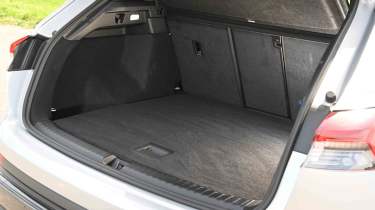
| Pros |
|
| Cons |
|
The Q4 e-tron’s cabin is impressively spacious, offering nearly as much leg and headroom as the larger Q6 e-tron. The boot is on the larger side of the class average, too.
Dimensions and size
As its name suggests, the Q4 e-tron’s falls squarely between the Q3 and Q5 in terms of length, but thanks to its electric platform, there is nearly as much space inside as you’ll find in Audi’s next largest electric SUV, the Audi Q6 e-tron. There are short overhangs front and rear, but again, this doesn’t compromise boot space.
| Dimensions comparison | |||
| Model | Audi Q4 e-tron | Kia EV6 | Tesla Model Y |
| Length | 4,588mm | 4,680mm | 4,790mm |
| Width | 1,865mm | 1,880mm | 1,982mm |
| Height | 1,639mm | 1,550mm | 1,624mm |
| Wheelbase | 2,764mm | 2,900mm | 2,890mm |
| Boot space | 520-1,490 litres | 490-1,300 litres | 890-2,138litres (measured to the roof) |
Driving position, seats & space in the front
The Q4’s driving position is high, so there’s a decent view of the road ahead, and the seat has loads of adjustment. Beneath the floating central dash section is a storage area for a smartphone, while the door bins are large and deep, too. The glovebox is only half-sized, however, due to the fuse box taking up part of the space.
Seats & space in the back
Passengers have loads of space to stretch out in the back of the Q4, and the seats are very comfortable, too. The angle of the backrests is a little more reclined than in a Tesla Model Y, which works in the Audi’s favour, while there’s loads of foot space, too.

Boot space
At 520 litres, the boot matches the likes of the Hyundai Ioniq 5 for overall volume. The Audi’s is more usable though, because the load bay is deeper, allowing for more bulky items to be loaded inside. Drop the rear seats and the volume grows to 1,490 litres. But the Q4 doesn’t have a front boot.
“The Q4 e-tron is more like a large hatchback than a 4x4, with a fairly standard ride height and short overhangs front and rear. Despite this, passengers won’t complain about a lack of head or legroom because it’s roomy inside, and there’s enough space in the boot for all their stuff.” – Alex Ingram, chief reviewer
Reliability & safety
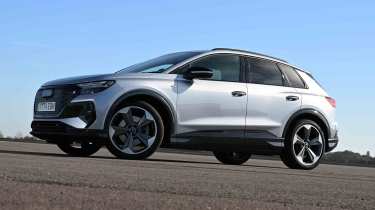
| Pros |
|
| Cons |
|
Audi has a reputation for producing stylish, premium cars with a high standard of fit and finish, but the brand has historically scored poorly in the Driver Power customer satisfaction survey. Praise where it's due, our latest survey data shows an improvement, jumping from 27th place in 2024, to 19th out of 31 manufacturers in 2025. That still means that the company finished a long way behind fellow premium electric car manufacturers BMW (8th) and Mercedes (2nd).
The Q4 e-tron retained its highest five-star safety rating from industry body Euro NCAP as part of its retest in 2025. It scored 91 per cent for adult occupant protection and 87 per cent for child passenger protection. The standard safety kit is good, with all cars getting cruise control with a speed limiter and lane-departure warning.
| Euro NCAP safety ratings | |
| Euro NCAP safety rating | Five out of five stars (tested in 2025) |
| Adult occupant protection | 91% |
| Child occupant protection | 87% |
| Vulnerable road user protection | 79% |
| Safety assist | 73% |
Buying and owning
Our best buy: Audi Q4 45 e-tron quattro S line
The 45 e-tron packs a punch, while the S line version features a sharper look, which adds a firmness to the ride, but it’s not so bad as to be uncomfortable. This trim level also comes with all the equipment you’d need, and S line specification usually holds its value better than other trim levels in the range.
Audi provides a fairly standard three-year/60,000-mile warranty with its cars, but buyers can increase this to either four years/75,000 miles or five years/90,000 miles of cover for extra peace of mind. A separate eight-year/100,000-mile guarantee covers the Q4 e-tron’s battery pack.
Electric vehicles require less maintenance than petrol and diesel cars because there aren’t as many moving parts in an electric motor, and fewer maintenance items to replace. Even their braking systems are subjected to less wear, because motor regeneration to top up an EV’s battery takes much of the effort away from traditional discs and pads.
However, it seems that nobody has informed the team that does the prices for Audi’s service plans, because, at the time of writing, a two-year package for the Q4 e-tron costs around £35 a month. That’s comfortably more than £800 over the course of two years.
Audi Q4 e-tron alternatives
If you want a posh Audi SUV, then the Q3 and Q5 are your petrol and plug-in hybrid alternatives. The Q4 is closer to the Audi Q3 in size, but the Q5 in price, while passenger space inside is on a par, if not better than the latter.
There are other premium contenders that the Q4 e-tron has to beat, and it holds up fairly well against them. It’s more efficient than the expensive Genesis GV60, its range is better than the BMW iX1, and it’s more roomy inside than the Mercedes EQA. The main contender in the small premium electric SUV class is the Tesla Model Y, which offers a long range, lots of kit and the convenience of the Supercharger network, as well as competitive pricing.
If you can’t get on board with a Tesla, then our other favourite in the class is the Hyundai Ioniq 5. It looks more like a hatchback than the Q4, but it’s big, and offers lots of space inside.
Deals on the Audi Q4 e-tron and alternatives
Audi Q4 e-tron 50 quattro: long-term test
In 2022, former Editor-in-chief, Steve Fowler, ran the now-discontinued Audi Q4 e-tron 50 quattro over a six-month, long-term test. He found the lower sports suspension on his S line model a little too firm, but was otherwise highly impressed by the car’s user-friendly design. The large boot area worked perfectly for his dog, Sky, and he found the underfloor storage space for the charging cables very handy. Steve averaged 3.2 miles per kWh on his test in mixed driving.
Audi Q4 e-tron pictures
Frequently Asked Questions
If you’re an Audi driver that wants to make the switch to electric, the familiarity of the Q4’s cabin will help boost your confidence in EV motoring. It’s a decent performer and has plenty of space inside, but there are some more accomplished rivals to choose from.








